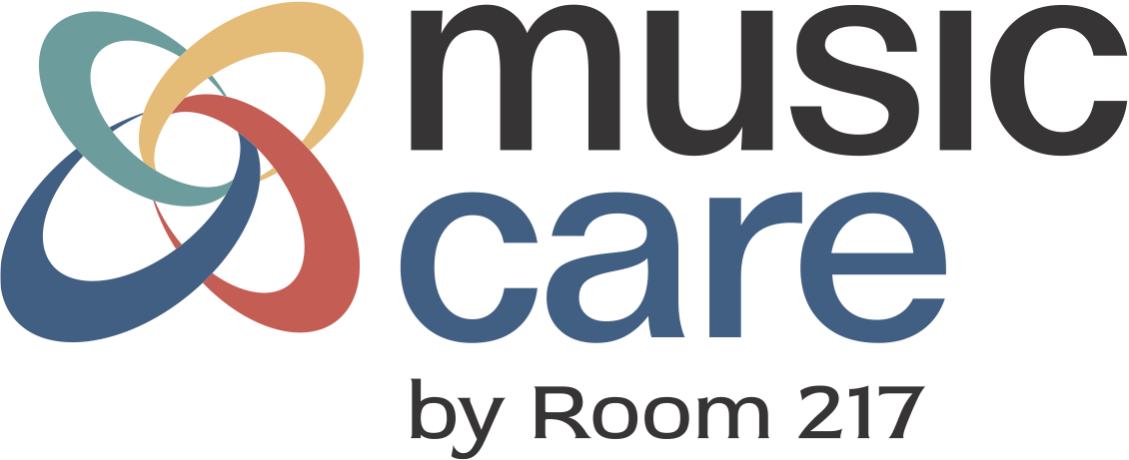Book Review
Book Review
Summaries, insights and opinions on the books we're reading
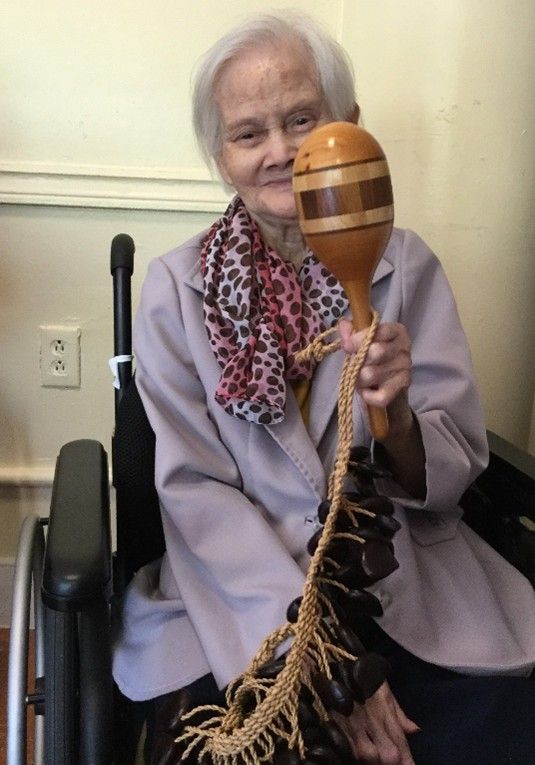
September 8, 2025 - Alzheimer’s Disease & Music Engagement: Quality of Life Economic Impact Analysis (Deloitte Canada, 2025)
Music engagement is proving to be more than a comfort for people living with Alzheimer’s disease (AD) and related dementias. It is showing measurable economic and quality of life impacts.
A new report released by Deloitte Canada on May 14, 2025, commissioned by the NeuroArts Blueprint Initiative and supported by AARP (American Association of Retired Persons), underscores the profound role music can play in dementia care.
The NeuroArts Blueprint Initiative, a collaboration between Johns Hopkins University and the Aspen Institute, is working to establish “neuroarts”- the science of how the arts impact the brain and body, as a recognized field of study and part of mainstream medicine. This report is the second in a series exploring the economic and social benefits of arts-based health interventions.
Music Engagement approaches and benefits for individuals with AD and other dementias
Music engagement uses music as a tool to enhance mood, evoke memories, and engage individuals in various activities. In active music engagement, the participant takes an active role in making music with a facilitator (non-clinical staff and family caregivers), including singing, playing an instrument, songwriting, dancing and physical exercise with music and stimulates cognitive processes allowing people to create and connect through music. In passive music engagement a participant listens to music rather than performs including relaxation, mindful music meditation. Another approach to music engagement is through music therapy where clinical use of personalized music interventions are conducted by a professional music therapist.
Results of music engagement alleviated physical symptoms such as agitation, pain, and discomfort, while also enhancing attention, communication, and interaction skills.
The research assessed how such engagement influences emotional, cognitive, social, and physical well-being for both individuals and their caregivers.
Quality of Life Gains
The review included a literature review identifying the variables music engagement has on both individuals with AD and their caregivers. These 9 quality of life metrics were identified and music engagement showed improved scores in positive impact for individuals with AD: activities of daily living (5%), agitation (4%), cognitive function (7%), depression (48%), emotional well-being (30%), loneliness and isolation (18%), neuropsychiatric symptoms (22%), quality-adjusted life years (0.018 QALYs) and sleep quality (30%).
Music engagement was also shown to improve quality of life for caregivers of individuals with AD. Three metrics were identified with improved scores: caregiver burden (30%), caregiver stress/distress (25%) and emotional well-being (25%).
The Economic Impact
Over 11 million Americans dedicate their time and effort to providing unpaid care for a family member or friend with dementia. This caregiving contribution is estimated to be worth almost $350 billion to the nation (US Alzheimer's Association, 2024).The report estimates that music engagement could yield between $5.1 billion and $11.9 billion annually in economic value, depending on its uptake in AD care. This impact comes from “downstream” effects such as reduced hospital visits, shorter stays, and lower institutional care costs.
Even more striking: for every dollar invested in music engagement, there is an estimated $2.40 return, a 2.4 times payback each year. Beyond dollars, the study translates improved outcomes into 13,550 to 31,610 Quality-Adjusted Life Years gained annually for individuals with AD.
Insights from the Field
Experts consulted for the report emphasized that music engagement delivers mostly short- to medium-term impacts, but these effects are consistent and meaningful. Music therapists stressed the importance of personalization, while caregivers highlighted the tangible relief music offers in daily routines. Together, these perspectives reinforce that music is both practical and transformative in dementia care.
Why It Matters
Globally, more than 55 million people are living with dementia, including 6.9 million Americans over 65. It is the most common form of dementia, accounting for approximately 60 to 80% of cases (US Alzheimer's Association, 2024) the economic burden associated with AD is substantial. While in 2024, health and long-term care costs for individuals with AD and related dementias are at $360 billion, it is projected this number will reach $1.5 trillion by 2050 with the growing number of cases (Nandi, A. et al., PJ Aging. 2024 Feb 8;10(1):13. doi: 10.1038/s41514-024-00136-6 ).
With no proven cure or prevention, non-pharmacological approaches like music are vital. Deloitte’s findings validate what many in the music care field have long observed: music is not only good for the soul, but also for health systems, caregivers, and the economy.
As Room 217 continues to advocate and offer solutions through training, standards and resources for music care, this report adds weight to the call for broader integration of music engagement into care programs. The evidence is clear, investing in music means investing in better lives for people with dementia and those who care for them.
To learn more about the NeuroArts Blueprint Initiative and the Deloitte report, visit: Alzheimer’s Disease & Music Engagement: Quality of Life Economic Impact Analysis :: Neuroarts Resource Center
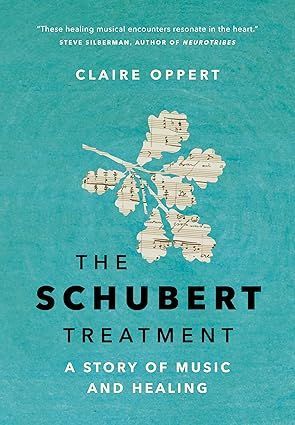
June 2025 - Claire Oppert’s The Schubert Treatment is a mesmerizing account of her life and work in healthcare settings, where she shares her musical gifts, and her “singing cello”, to promote healing. Oppert’s stories are remarkable, told with an uncompromising sense of deep regard and compassion for those she plays for. A classically trained cellist born and raised in France, Oppert was drawn to healing, no doubt influenced by a long legacy of doctors, most notably her father, who was known to sit at the piano during house calls and play a Chopin nocturne. “Everything is much better. I’ll see you next week,” he would say, sometimes without even examining the patient. Raised with a profound sense of calling and a supremely clear belief in the therapeutic power of music, Oppert began visiting nursing homes, special education schools, and palliative care units throughout France to play for care recipients.
The term The Schubert Treatment was first coined by a nurse who witnessed Oppert sit and play for a patient suffering from dementia-related agitation and violence, enabling the nurses to complete wound care. “You’ll have to come back,” one of them laughs. And she does, later that week, twice, as the resident at Korian Jardins d’Alésia has her dressing changed and her pain alleviated while listening to the andante from Schubert’s Trio over and over. “Her face glows so intensely luminous that it lights up the whole room, the nurses and me,” Oppert writes. She goes on to use the Schubert Treatment with over one hundred patients in end-of-life care. One doctor sums up the impact of the protocol: “Ten minutes of Schubert is the equivalent of five milligrams of oxy.”
Oppert’s writing is poetic, rich with metaphor, capturing the fragility of life and the ways in which art intensifies, accompanies, and flows through the human experience. At times, it’s difficult to tell whether she is writing figuratively or literally, as her words strive to express the mysterious, transformative ways music touches the patients she visits, “those described as deeply autistic, care-home residents, people with dementia, those experiencing pain, and individuals nearing the end of their lives”.
Her musical and artistic interventions are often filled with whimsy, including co-creating poetry with those she visits. “Music speaks to something vital… something essential within us, the most beautiful part of us. It transforms the person who is singing. It’s a miracle,” says Madam Kessler who lives in the dementia ward she visits. “We’re not afraid of making mistakes here,” says Madame Oliver, who suffers from schizophrenia. “We feel important now. We feel good. We feel at home.” Another resident with dementia adds, “Yes, we feel like we belong.”
Oppert’s visits also create moments of existential consolidation in the form of a collaborative autobiography. Madame Vaillant’s memories, previously inaccessible, locked away by dementia become crystallized after listening to Oppert play Bach’s gigue. Her life stories begin to flow like rivers, lovingly regaled, recorded and preserved by Oppert in the form of a published memoir. This legacy becomes a touchpoint for Madam, a reminder of the honored life she has led, proof of her purpose and her contribution, the impact she has made in life.
Oppert also takes us with her on visits to children and young adults deemed uncommunicative due to autism, who come to life, find peace, and regulate to the sound of the cello. Even when one young person, overwhelmed by frustration, lashes out and strikes her cello, Oppert does not retreat. She perseveres, choosing connection over fear, and remains present with the deep belief that “yes, there is someone in there, without a doubt.”
Woven throughout these episodes of joy, breakthrough, comfort, and solace are Oppert’s own stories, her time at the Moscow Conservatory in Communist Russia, enduring the relentless tutelage of masters who shaped her into the cellist she is today. She also reflects on the young musicians she has mentored, recognizing sparks of brilliance in students who others might have overlooked.
To glimpse the artistry of this extraordinary woman is a pure privilege. Claire Oppert’ passion and impact extend beyond her musical genius, as she devotes herself to accessing though her cello’s songs, the patient’s very essence, to interpreting the souls of those who can no longer advocate for themselves. I cannot recommend this book enough; I am more for having read it.
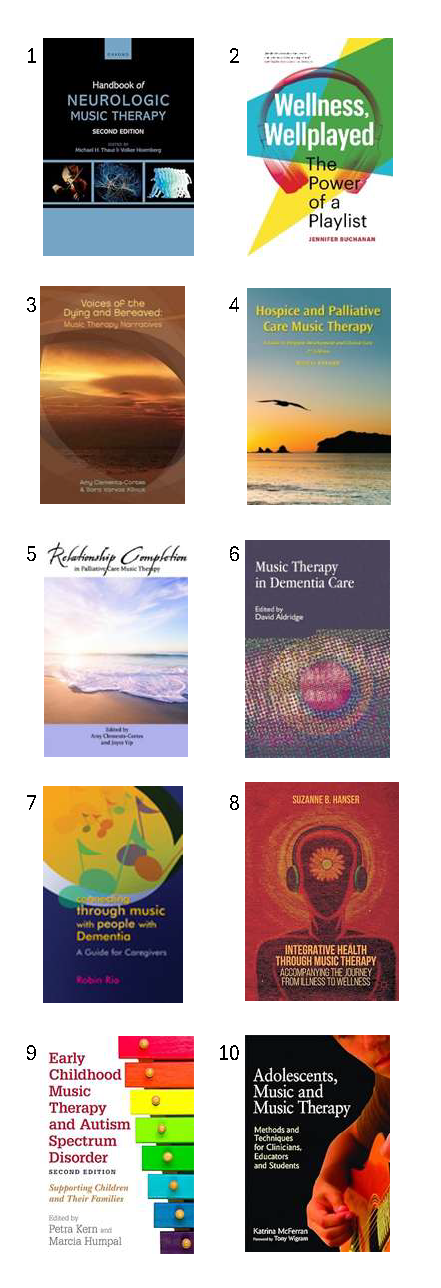
March 2025 - March is Music Therapy month. We celebrate our music therapy colleagues. Many of them are both clinicians and researchers who write and publish their work.
Music therapists may self-publish, but typically are published through Jessica Kingsley Publishers, Barcelona Publishers and Oxford Press.
We’ve picked 10 of our favourite music therapy authored/edited books to share.
- Handbook of Neurologic Music Therapy, 2nd
Edition, Michael H. Thaut, Volker Hömberg, 2025.
- Wellness, Well-Played: The Power of a Playlist, Jennifer Buchanan, 2021.
Take a deep dive and learn how to use musical playlists purposefully, to feel, create, and connect. - Voices of the Dying and Bereaved: Music Therapy Narratives, Author: Clements-Cortes, Amy, & Klinck, Sara V., 2016.
- Hospice and Palliative Care Music Therapy: A Guide to Program Development and Clinical Care, 2nd ed. Russell Hilliard, 2018.
- Relationship Completion in Palliative Care Music Therapy, Author: Clements-Cortes, Amy, & Yip, Joyce (Eds.), 2016.
- Music Therapy in Dementia Care, Aldridge (Ed), 2008.
- Connecting through Music with People with Dementia, A Guide for Caregivers, Robin Rio, 2009.
- Integrative Health through Music Therapy: Accompanying the Journey from Illness to Wellness, Suzanne Hanser, 2016.
- Early Childhood Music Therapy and Autism Spectrum Disorder, Second Edition: Supporting Children and Their Families, Petra Kern, Marcia Humple (Ed), 2018.
- Adolescents, Music and Music Therapy: Methods and Techniques for Clinicians, Educators and Students, Katrina McFerran, 2010.
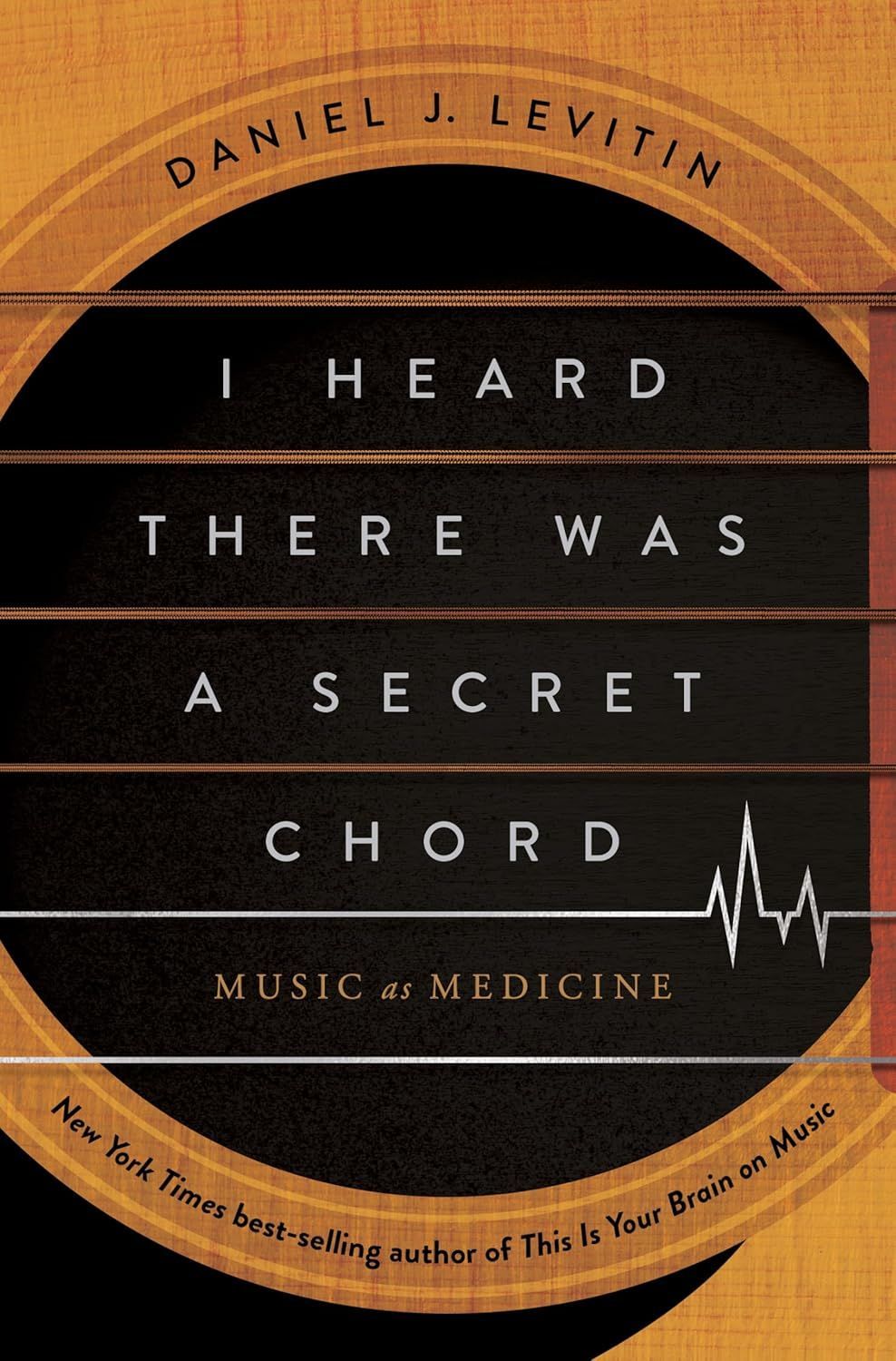
January 2025 - The intersection of neuroscience and music is a continued fascination for us at Room 217, and Daniel Levitin’s “I Heard There Was a Secret Chord” is a book that provides a thoroughly satisfying read. Levitin is like a masterful cartographer who takes us on a journey of the brain, acquainting us, so artfully of its complexities and capabilities while explaining the magic we feel when listening to music. His writing treats the brain like a beloved friend, revealing its limitations and potential, its mechanistic biological responses and its deeply individual empathic responses. Levitin answers complex questions about why music moves us so profoundly, transforms our experiences, and uniquely connects us to memory.
Striking a balance between detailed explanation while always remaining accessible to the lay person, Levitin shares stories and emerging evidence from current research. What makes this book stand out among others on the topic is Levitin’s recognition of music’s potential as a medical tool. He references historical figures who supported this idea, from Philipp Friederich Freiherr ca. 1799 to Nietzsche and neurologist Oliver Sacks, a pianist himself, who stated, “My medical sense is a musical one. I diagnose by the feeling of discordancy, or some particularity of harmony.”
Levitin describes how music activates various brain centers involved in short-term memory, movement, emotion, prediction, reward, and more. These revelations highlight music’s unique capacity to support mental health, mood disorders and addictions, aid in treating movement disorders like Parkinson’s disease, treat pain through distraction impacting neurodevelopmental disorders such as Williams syndrome (WS) and stimulate cognition in degenerative diseases like dementia. Notably, Levitin suggests that each of the five domains of human experience—physical, cognitive, social, emotional, and spiritual—is affected by either listening to or playing music, unlike any other activity. This resonated with me personally, recalling the sheer joy I experienced playing in senior band; creating music together with my peers was an incomparable source of happiness and connection during adolescence. The pro-social and developmental benefits of music are invaluable to keep in mind for educators and anyone supporting youth, given music's impact on brain development.
One of Levitin's key insights is how uniquely the brain perceives music, explaining why we all have distinct tastes and preferences. Music affects each of us differently, and its positive impact depends on a personal, meaningful connection with what we hear. Songs we love trigger hormonal releases that create "frisson," those chills of awe and beauty we experience. Conversely, when exposed to music we dislike—say, heavy metal in a quiet grocery store—the amygdala is activated, producing a fear response and the accompanying physical response, that being fight or flight.
Levitin’s exploration of music and the brain combines scientific depth with a genuine passion for the subject, leaving readers with a deeper appreciation for music’s profound influence on human life. One particularly inspiring insight is that re-engaging with music in middle age or beyond—by playing an instrument, for example—can actually help the brain remodel itself, thanks to its ongoing plasticity, which defies previous beliefs that it ceases with age. Reading “I Heard There Was A Secret Chord” reinforces our conviction at Room 217 that music has a transformative power in healing and care, benefiting individuals at every stage of life.
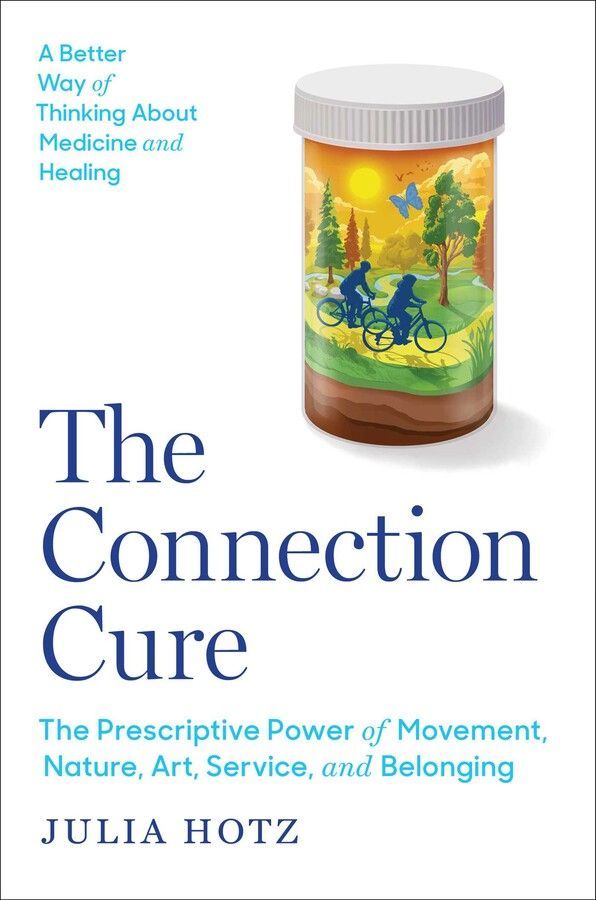
September 2024 - Music is the great connector and at so many levels. It is around interpersonal connection made through the arts and other basic human staples that Julia Hotz explores in her new book, The Connection Cure. The reader experiences a global kaleidoscope of the emerging practice of social prescription, a nonmedical resource or activity that aims to improve a person’s health and strengthen their community connections.
Hotz, an American journalist, investigates how social prescription is being used to treat social determinants of health with specific stories and programs from ten countries. The basic tenet is that we’re not wired to live disconnected from our environments.
Moving our bodies, observing nature, creating art, serving our neighbours, and seeking belonging are core ingredients to reclaiming human interconnectedness for our wellness. Hotz says it this way: “We know that what really matters in the grand scheme of life are the connections in our environments: the joy and meaning we experience, and the relationships we build.”
Hotz is clear to point out that social prescription doesn’t replace medicine, rather complements it by reconnecting us to our sources of wellness. She relates stories of individuals living with type 2 diabetes, PTSD, depression, panic attacks, dementia and other ailments who have participated in unique community programs with life-changing outcomes. Hotz weaves relevant research throughout in an easy-to-read, comprehensive style.
Notably in chapter 7, there is a shout out to Dr. Kate Mulligan and the work being done at the Canadian Institute for Social Prescribing. Mention is made that the Ontario-based Alliance for Healthier Communities launched Canada’s first formal social prescribing pilot in 2018 called Rx: Community.
Piqued your interest? If you are looking for a better way of thinking about medicine and healing, then this is a must read. Highly recommended.
Subscribe to MUSIC CARE eNews

